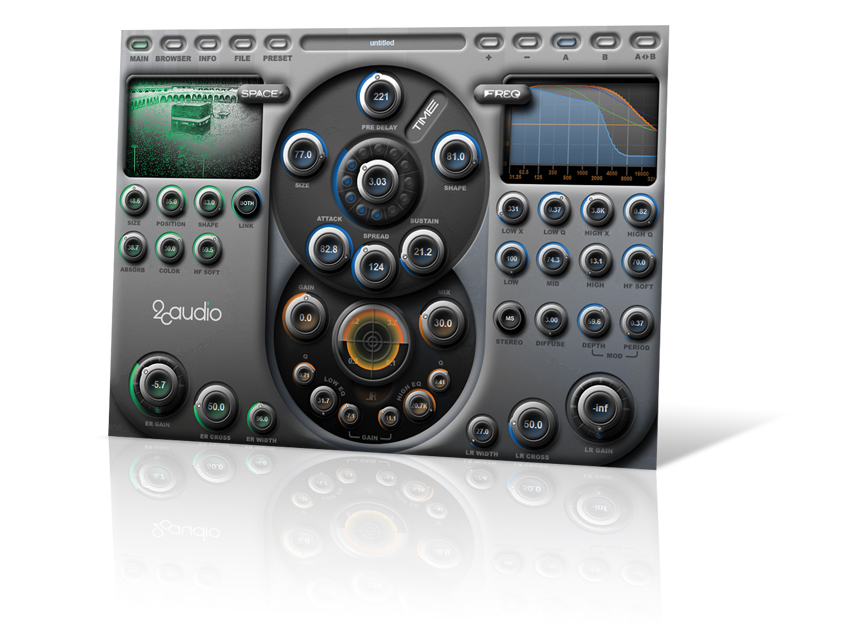MusicRadar Verdict
One of the best algorithmic reverbs we've ever heard, although it may appear intimidating to the novice.
Pros
- +
Fantastic sound quality. Great for both mixing and sound design. Highly useful tail envelope controls. Excellent categorised presets. ER Space presets system is very cool.
Cons
- -
Complex parameter set. No easy mode or tooltips.
MusicRadar's got your back
Newcomer 2CAudio is clearly intent on making a mark with its debut plug-in, Aether, which it describes as an "ultimate fidelity auto-randomizing algorithmic reverb", citing a whole load of other techie-sounding features.
The allusion to randomness is in reference to the chaotic workings of the underlying algorithms, however, so there's no need to worry that your Aether-soaked mixes will sound totally different each time you load them up!
In detail
As with many digital reverb plugins, Aether offers independent control over the early reflections (ER), and reverb tail (aka late reflections or LR). The interface houses over 70 parameter knobs, colour-coded to clarify their functions. The orange controls deal with the overall gain, dry/wet balance and input EQ (visually represented by an orange line on the top-right graph - the other sections' EQs are displayed likewise).
The ER panel is considerably more interesting - it features a Space parameter, whereby one can choose from 33 preset "acoustic spaces". These aren't merely preset parameter values, as they actually change the room data used by the algorithm to create the early reflections.
Other controls include Absorption (of sound energy by the virtual surfaces), Position (of the source within the space), Shape (which causes the sound to become less linear), Color (like a brightness control), HF Soft (a high-shelving filter), and stereo crossover via the ER Cross knob. It pays to read up on all these parameters, so that you can steer the sound where you wish.
It's worth noting that, with the LR section disabled, the ER spaces alone are ideal for thickening up or widening sounds without adding a noticeable reverb tail. You can even increase the Size setting until the short delays that comprise the early reflections become a very usable slapback effect.
On to that LR section, and the rightmost portion offers the Freq panel, with its damping EQ section (with slightly confusing parameter names) and control over the stereo operation of the reverb (the manual goes into great detail about this). You can also define the level of diffusion (ie, perceived smoothness) and degree of modulation applied to the tail (broadly speaking, a sort of subtle chorus-like effect).
Want all the hottest music and gear news, reviews, deals, features and more, direct to your inbox? Sign up here.
The Time panel offers predelay and overall reverb length parameters. The Size control determines the virtual room size, ie, time between echoes (although these blur together in the LR stage to become a 'tail', this still greatly influences the sound). Increasing the Shape knob gives a sound with varying echo timings (a low setting corresponds to a rectangular room, with more regular echoes).
Less common for a reverb plug-in are the Attack, Sustain and Spread controls, which enable manipulation of the overall envelope of the tail. This is highly effective and means you can subtly shift the 'energy' of the reverb until it sits nicely in the mix.
In use
It took us a little time to become familiar with Aether's control set - an 'easy mode' or tooltips would be welcome - but we were getting great results right away thanks to the superb categorised presets, which range from the ever-useful hall/room reverbs to bizarre ambient effects.
We used Aether on a variety of material, such as real instrument mixes and synth-heavy electronic music, and found it to be a winner in all cases - it creates a clear sense of space with no clouding of the sound. And once you've got your head around all those controls, you can really go to town on sculpting the reverb.
Aether is one of the few plug-in reverbs we've heard that can yield the kind of subtly animated, liquid spaciousness - not to mention the sort of bonkers 'special effects' - that you'd associate with a pricey hardware unit. Oh, and the CPU usage is reasonable, too. What's not to love?
Listen to these audio clips - first dry and then with Aether applied:
Percussion
Rhythm guitar
Gated synth
Computer Music magazine is the world’s best selling publication dedicated solely to making great music with your Mac or PC computer. Each issue it brings its lucky readers the best in cutting-edge tutorials, need-to-know, expert software reviews and even all the tools you actually need to make great music today, courtesy of our legendary CM Plugin Suite.

